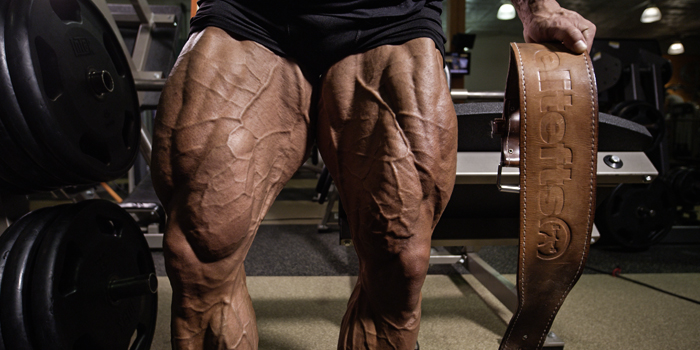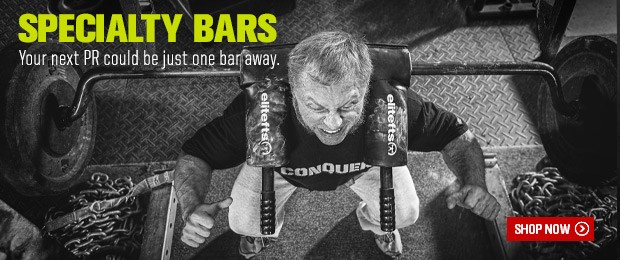
Pretty much anyone familiar with pushing iron knows the basic lifts: the bench, squat, and deadlift. They comprise the basis from which powerlifting totals are built and underpin many bodybuilding programs. Competitive powerlifters invariably are joined in matrimony to these three lifts. Collectively pushing the limits for powerlifters matters greatly, whereas a bodybuilding judging panel cares as much about your IQ as they do about your combined total on the bench, squat, and deadlift. Mass, symmetry, proportion, conditioning and presentation matter more in bodybuilding than the raw numbers moved in the gym. Yet everyone seems to be drawn to these exercises. Maybe it’s because of the standard gym bro question: how much do you bench?
MORE: Bodybuilding Exercises for Powerlifters — Adductor Work for Added Gains
Bragging rights aside, in this particular article I plan to share with you some of my best alternatives to the basic lifts. Yes, I have routinely performed at least two of the three lifts on a regular basis in the past. However, in all honesty, alternatives of these basic lifts did more for the development of my physique and hypertrophy in general. All my injuries came on the basics: pec tear with 500 pounds on bench press, low spine injury squatting 700 pounds, and worse in regard to deadlifts. There’s something inherently wired in me to want to push my own limits on the basics, even though their importance was minimal in my given endeavor of bodybuilding. If you’re beat up from powerlifting or more concerned with hypertrophy, some of these variations may prove useful.
Bench Press Alternatives
The standard barbell bench press and its incline and decline variations are useful for pec development, but I prefer to use them in more non-traditional ways. Pretty much every pec tear I’ve ever heard of came on the heels of moving or attempting to move serious pounds with a barbell while lying on a bench. Consider these alternatives.
Floor Presses
How: Set up a rack or even a Smith machine in such a manner that you can lay on the floor and perform presses.
Here is a sample video:
Why: Floor presses don’t allow your elbow to go back beyond 90 degrees, which makes them safer for the rotator and the pec tendon insertion by not overstretching at the bottom.
Hanging Band Technique (HBT) Presses
How: With the aid of elitefts bands you can hang 10- or 25-pound plates from the end of the bar to create instability.
Here is a sample video:
Why: The instability of the hanging weight makes the bar oscillate, causing recruitment of more muscle fibers and forcing you to maintain tighter form, both of which lead to greater muscle stimulation in a safer manner.
Dumbbell Bench Press with Drops
How: Rather than pressing with a barbell you simply use dumbbells and perform a drop set for added pec stimulation.
Here is a sample video:
Why: Dumbbells allow for a more natural movement pattern than a barbell. I prefer to tuck my elbows into my side slightly to take the stress off the pec insertion. Adding a drop set vastly increases the intensity level without compromising safety.
Barbell Squat Alternatives
Truth be told, most of my significant quad development over the years came from leg presses, but in my 20s I loved to squat. There’s just something exhilarating about stepping out from the rack with a bunch of weight on your back and a hint of fear that it might crush you if you don’t get out of the hole. Unfortunately, the discs in my lower back didn’t hold up as well as my resolve to move more weight. Here are some safer alternatives that I still implement into my training to this day.
Bulgarian Split Squats
How: Elevate your back leg onto the bar from a Smith machine, grab a dumbbell, and perform split squats. Performing a drop set with isoholds at the mid-point of the rep range takes this exercise to a whole new level.
Here is a sample video:
Why: This exercise puts a tremendous amount of tension on the quads and glutes with a fraction of the weight most people add to a traditional squat bar, making it much more spine and knee friendly.
Cambered Bar Squats with Chains
How: Perform traditional squats using an elitefts rackable cambered bar and some chains hanging from an EZ Loader Strap.
Here is a sample video:
Why: The cambered bar benefits my lower back because I don’t overarch getting my hands back as with a traditional barbell, thus allowing my spine to bear the load in a more comfortable position. People with shoulder rotator issues tend to benefit from this bar as well. The chains serve to deload the weight at the bottom, where people often experience back and knee pain in that transition point between the eccentric and concentric phase of the movement.
Deadlift Alternatives
Deadlifts were never my thing, perhaps due to how my body is put together. I did work them into my program from time-to-time until the day my back went out on me pulling a measly 405 pounds. Nearly forced to crawl to my car, I swore off deadlifts from that day forward. Any benefits attributable to deadlifting were not worth being laid up for a week popping muscle relaxers. These became some of my go-to alternatives.
Modified Pulley Rack Pull
How: Use some carabiners to extend the bar attachment on a seated pulley row to minimize over-stretching and straining your lower back. Pull the weight like you would with a rack pull as you arch your back and keep your lats tensed. Do not pull with your arms.
Here is a sample video:
Why: This exercise hits traps, spinal erectors, and lats similar to a rack pull, but without the direct compression of the spine as in a traditional deadlift. It pretty much takes your legs out of the movement.
Dead-Squat Bar Pulls
How: Using a dead-squat bar or elitefts trap bar, perform deadlifts from either the floor or rack.
Here is a sample video:
Why: The dead-squat bar allows for a more natural, centered pulling position to prevent rounding in the lower back. Using a rack keeps the focus more on the upper body, specifically back, more so than the glutes, hamstrings, and quads.
Dumbbell Rows
How: Grab a relatively heavy dumbbell and pull from the floor, driving your elbow up and back. Pull slightly towards your hip and really allow the weight to stretch you at the bottom.
Here is a sample video:
Why: Dumbbell rows did more for my back development than deadlifts ever did, and proved over time to be much more lower spine friendly for me personally. Grinding out some heavy dumbbell rows with good form will fast track your back thickness.
Everyone is built differently, which means not all exercises suit everyone equally. In bodybuilding, it’s about how big the muscle appears on stage, not your body’s ability to create leverage to move weight in the gym. If bodybuilding is your goal, focus on finding exercises that stimulate hypertrophy and minimize the risk of injury. Plan time away from the gym to ensure muscle recovery and growth rather than needing unplanned time to hopefully heal from serious injury.











All the Best,
Mark